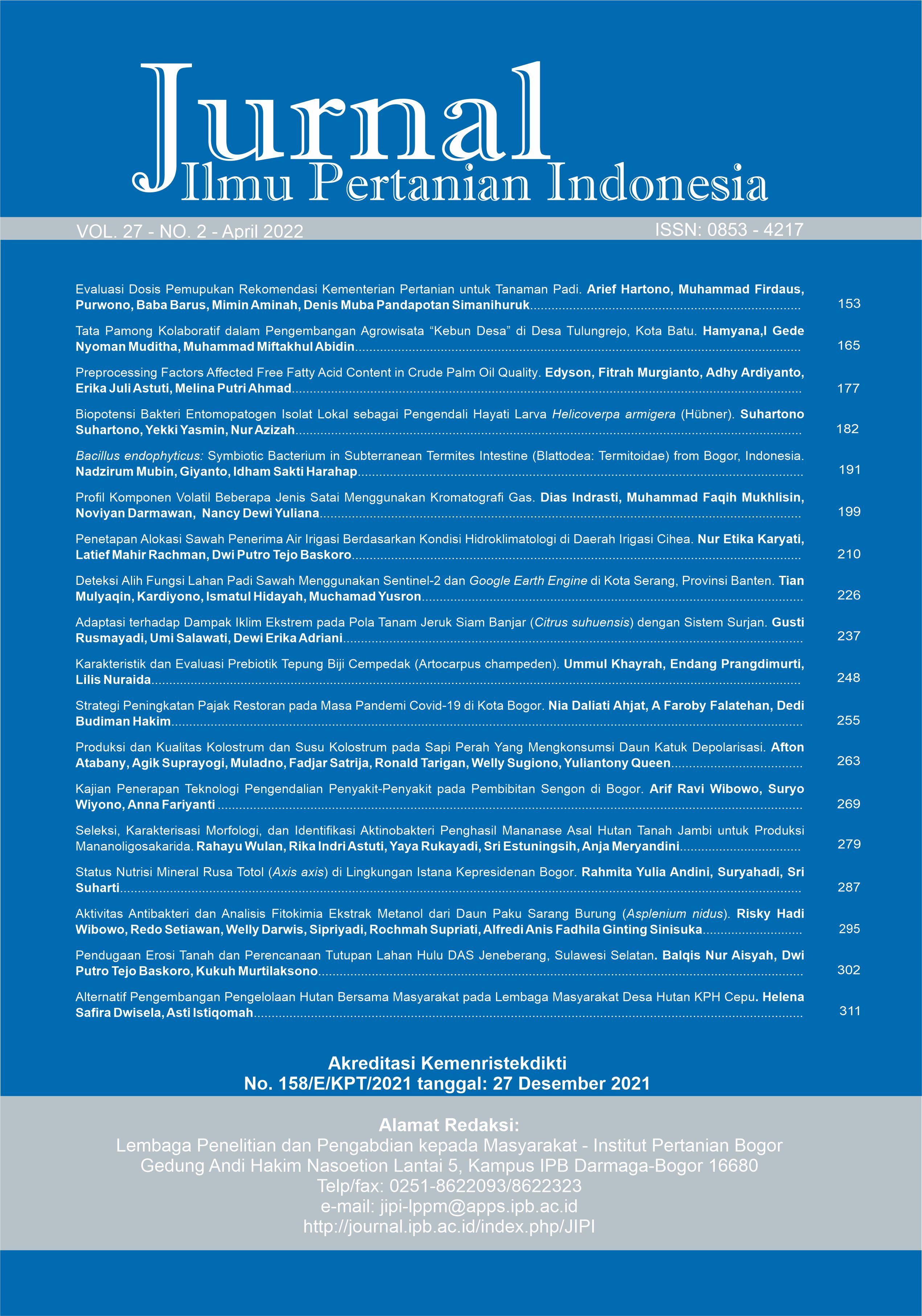Deteksi Alih Fungsi Lahan Padi Sawah Menggunakan Sentinel-2 dan Google Earth Engine di Kota Serang, Provinsi Banten
Abstract
Land is one of the main factors in rice production. However, the transfer of agricultural land functions to other sectors continues and becomes a challenge in the food supply in Indonesia. Serang City is one of the rice-producing areas in Banten Province. This study aims to analyze changes in the transfer of rice field functions to other sectors by mapping rice field cover using Sentinel-2 satellite imagery in 2021 compared to 2019 with the Random Forest method by using Google Earth Engine (GEE) applications and cloud computing support. The study results showed that the cover of rice fields in Serang City in 2021 decreased by 602.87 ha (-7.20%) compared to 2019 from the total land cover. Land cover in other vegetation was also reduced by 242 ha (-2.45%), while urban land cover in 2021 increased by 781.82 ha (10.89%). This study shows that there has been a change in land transfer in Serang City due to urban expansion in 3 years, as well as that the use of GEE can streamline monitoring of changes in land transfer and land use cover.
Keywords: rice field, Google Earth Engine, Sentinel-2
Downloads
References
BPS-Statistic of Serang Municipality. 2020. “Serang Municipality in Figure 2020.” https://serangkota.bps.go.id/publication/2020/04/27/354286a76093052203a44878/kota-serang-dalam-angka-2020.html (February 3, 2021).
Descals, Adria et al. 2019. “Oil Palm (Elaeis Guineensis) Mapping with Details: Smallholder versus Industrial Plantations and Their Extent in Riau, Sumatra.” Remote Sensing 11: 2590.
Gascon, Ferran et al. 2017. “Copernicus Sentinel-2A Calibration and Products Validation Status.” Remote Sensing 9(6): 584.
Gorelick, Noel et al. 2017. “Google Earth Engine: Planetary-Scale Geospatial Analysis for Everyone.” Remote Sensing of Environment 202: 18–27.
Jean, Neal et al. 2016. “Combining Satellite Imagery and Machine Learning to Predict Poverty.” Science 353(6301): 790–94.
Johansen, Kasper, Stuart Phinn, and Martin Taylor. 2015. “Mapping Woody Vegetation Clearing in Queensland, Australia from Landsat Imagery Using the Google Earth Engine.” Remote Sensing Applications: Society and Environment 1: 36–49.
Miettinen, Jukka, David L.A. Gaveau, and Soo Chin Liew. 2019. “Comparison of Visual and Automated Oil Palm Mapping in Borneo.” International Journal of Remote Sensing 40(21): 8174–85.
Mutanga, Onisimo, and Lalit Kumar. 2019. “Google Earth Engine Applications.” Remote Sensing 11(5): 591.
Nguyen, Luong Bang. 2020. “Land Cover Change Detection in Northwestern Vietnam Using Landsat Images and Google Earth Engine.” Journal of Water and Land Development 2020: 8.
Nyuytiymbiy, Kizito. 2021. “Parameters and Hyperparameters in Machine Learning and Deep Learning.” Medium. https://towardsdatascience.com/parameters-and-hyperparameters-aa609601a9ac (April 22, 2021).
Piragnolo, M., G. Lusiani, and F. Pirotti. 2018. “COMPARISON OF VEGETATION INDICES FROM RPAS AND SENTINEL-2 IMAGERY FOR DETECTING PERMANENT PASTURES.” ISPRS - International Archives of the Photogrammetry, Remote Sensing and Spatial Information Sciences XLII–3: 1381–87.
Ramadhani, Fadhlullah, Reddy Pullanagari, Gabor Kereszturi, and Jonathan Procter. 2020. “Automatic Mapping of Rice Growth Stages Using the Integration of SENTINEL-2, MOD13Q1, and SENTINEL-1.” Remote Sensing 12(21): 3613.
Shaharum, Nur Shafira Nisa et al. 2020. “Oil Palm Mapping over Peninsular Malaysia Using Google Earth Engine and Machine Learning Algorithms.” Remote Sensing Applications: Society and Environment 17: 100287.
Shelestov, A. et al. 2017. “Large Scale Crop Classification Using Google Earth Engine Platform.” In 2017 IEEE International Geoscience and Remote Sensing Symposium (IGARSS), , 3696–99.
Van der Werff, Harald, and Freek Van der Meer. 2016. “Sentinel-2A MSI and Landsat 8 OLI Provide Data Continuity for Geological Remote Sensing.” Remote Sensing 8(11): 883.
Zhang, T. et al. 2017. “Band Selection in Sentinel-2 Satellite for Agriculture Applications.” In 2017 23rd International Conference on Automation and Computing (ICAC), , 1–6.
This journal is published under the terms of the Creative Commons Attribution-NonCommercial 4.0 International License. Authors who publish with this journal agree to the following terms: Authors retain copyright and grant the journal right of first publication with the work simultaneously licensed under a Creative Commons Attribution-NonCommercial 4.0 International License. Attribution — You must give appropriate credit, provide a link to the license, and indicate if changes were made. You may do so in any reasonable manner, but not in any way that suggests the licensor endorses you or your use. NonCommercial — You may not use the material for commercial purposes.






















